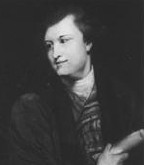
In 1760 a young Edinburgh schoolmaster named James Macpherson (1736-1796) published a translation of ancient Scottish verse titled
Fragments of Ancient Poetry, Collected in the Highlands of Scotland, and Translated from the Gaelic or Erse Language. The book received an enthusiastic response. Admirers, including fellow Scots James Boswell and Hugh Blair, raised a subscription to allow Macpherson to further research ancient Scottish verse.
Macpherson traveled to various remote areas of Scotland and claimed that during his travels he discovered an epic poem written in Gaelic by a third-century bard named Ossian. The poem was about a mythological character named Fingal.
In December 1761 Macpherson published a translation of this poem which he titled
Fingal, an Ancient Epic Poem in Six Books, together with Several Other Poems composed by Ossian, the Son of Fingal, translated from the Gaelic Language.
Two years later Macpherson published a translation of a second epic poem,
Temora, and in 1765 he produced a collected edition titled
The Works of Ossian.
Scottish Pride and Romanticism
The poems became international successes and propelled Macpherson to fame and riches. A mood of anti-rational Romanticism was sweeping across Europe, and this helped to boost the popularity of the poems. Eighteenth-century readers found that the simple, melancholy virtues of the heroic characters in the poems provided an appealing contrast to the complexity and deceit of the modern world.
In fact, Macpherson's translations are widely credited with helping to usher in the romantic movement in European literature. His fans included the German poet Goethe. Even Napoleon declared
The Works of Ossian to be one of his favorite books.
In addition, the discovery of an ancient literature older than any England or Ireland could boast appealed to Scottish cultural nationalism.
Criticism
Not all were impressed, especially not Dr. Samuel Johnson, one of the most famous literary figures of that era. Johnson became convinced that the Ossian poems were fakes. To him the verse didn't sound like it had been written by a third-century bard. Instead, it sounded to him like what an overly romantic contemporary writer would imagine that a third-century bard would sound like.
While touring Scotland in 1773 Samuel Johnson searched for the original Gaelic manuscripts that Macpherson had translated. He couldn't find them, and he returned home to denounce the works as fakes.
What followed was a bitter controversy about the authenticity of the works. Macpherson kept promising to produce the Gaelic originals, but never did. At one point he produced some passages written in Gaelic, but it later turned out that these were passages he had clumsily translated from English into Gaelic.
The feud between Macpherson and Johnson became so bitter that at one point Macpherson sent Johnson a threatening letter. Johnson, believing Macpherson might physically attack him, subsequently slept with an oak staff by his side to protect himself.
It wasn't until Macpherson's death that scholars got a chance to examine his sources. Then it became clear that while there were some legitimate manuscript sources, Macpherson had greatly expanded and altered them. In other words, the poems were principally written by Macpherson himself, not by a third-century Scottish bard.
Although Macpherson is now mainly remembered as a fraud, he did help to draw attention to the ancient and disappearing oral tradition of Scottish balladry, which was real.
Ironically, Macpherson was buried in Westminster Abbey, close to Dr. Johnson.
Links and References
- Haywood, Ian. The Making of History: A Study of the Literary Forgeries of James Macpherson and Thomas Chatterton in Relation to Eighteenth-Century Ideas of History and Fiction. Rutherford, NJ: Fairleigh Dickinson University Press, 1986.
- Murphy, Peter T. "Fool's Gold: The Highland Treasures of MacPherson's Ossian. ELH, Volume 53, Issue 3 (Autumn, 1986): 567-591.
- Gray, Paul. (May 16, 1983). "Fakes that have skewed history." Time.

 In 1760 a young Edinburgh schoolmaster named James Macpherson (1736-1796) published a translation of ancient Scottish verse titled Fragments of Ancient Poetry, Collected in the Highlands of Scotland, and Translated from the Gaelic or Erse Language. The book received an enthusiastic response. Admirers, including fellow Scots James Boswell and Hugh Blair, raised a subscription to allow Macpherson to further research ancient Scottish verse.
In 1760 a young Edinburgh schoolmaster named James Macpherson (1736-1796) published a translation of ancient Scottish verse titled Fragments of Ancient Poetry, Collected in the Highlands of Scotland, and Translated from the Gaelic or Erse Language. The book received an enthusiastic response. Admirers, including fellow Scots James Boswell and Hugh Blair, raised a subscription to allow Macpherson to further research ancient Scottish verse.
Comments